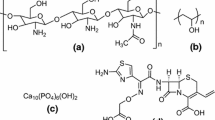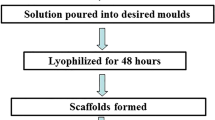Abstract
Castor oil (CO) as an inexpensive green polyol possesses antimicrobial and anti-inflammatory and wound healing properties. The castor oil/nanohydroxyapatite (nHA) modified chitosan (CS) composite (CO/nHA-CS) with 1. 2.5, 5, and 7.5 wt% of nHA-CS were synthesized via solution mixing and casting technique. The crystal structure, surface functional group, thermal stability, morphology, water absorption capacity, porosity, biodegradability, antibacterial activity, and cytocompatibility properties of CO/nHA-CS bionanocomposites have been evaluated. FESEM images showed random and uniform dispersion of nHA-CS fillers throughout the cured CO resin. The degree of porosity, water absorption, and biodegradability of the nanocomposites increased with the increase in nHA-CS loading. Antibacterial activity of scaffolds against Escherichia coli and Staphylococcus aureus bacteria was identified by the diffusion method. The scaffolds were more effective against the growth of Staphylococcus aureus than Escherichia coli. Cell viability results confirmed that CO/nHA-CS composites have no toxic effects against MRC-5 fibroblast cells. In conclusion, CO/nHA-CS has the potential to be explored as a cheap and effective wound healing material.













Similar content being viewed by others
Code availability
Not applicable for that section.
References
Venus M, Waterman J, McNab I (2010) Basic physiology of the skin. Surgery (Oxford) 28(10):469–472. https://doi.org/10.1016/j.mpsur.2010.07.011
Sinno H, Prakash S (2013) Complements and the wound healing cascade: an updated review. Plast Surg Int 2013:1–7
Jones I, Currie L, Martin R (2002) A guide to biological skin substitutes. Br J Plast Surg 55(3):185–193. https://doi.org/10.1054/bjps.2002.3800
Lligadas G, Ronda JC, Galia M, Cádiz V (2010) Plant oils as platform chemicals for polyurethane synthesis: current state-of-the-art. Biomacromol 11(11):2825–2835. https://doi.org/10.1021/bm100839x
Wang HJ, Rong MZ, Zhang MQ, Hu J, Chen HW, Czigány T (2008) Biodegradable foam plastics based on castor oil. Biomacromol 9(2):615–623. https://doi.org/10.1021/bm7009152
Narine SS, Kong X, Bouzidi L, Sporns P (2007) Physical properties of polyurethanes produced from polyols from seed oils: II. Foams. J Am Oil Chem Soc 84(1):65–72
McGarey WA (1993) The oil that heals: a physician's success with castor oil treatments. ARE Press. https://books.google.co.in/books?id=pWOMrqQ24AIC
Koc H, Kilicay E, Karahaliloglu Z, Hazer B, Denkbas EB (2021) Prevention of urinary infection through the incorporation of silver–ricinoleic acid–polystyrene nanoparticles on the catheter surface. J Biomater Appl 36(3):385-405. https://doi.org/10.1177/0885328220983552
Totaro G, Cruciani L, Vannini M, Mazzola G, Di Gioia D, Celli A, Sisti L (2014) Synthesis of castor oil-derived polyesters with antimicrobial activity. Eur Polym J 56:174–184. https://doi.org/10.1016/j.eurpolymj.2014.04.018
Mao J, Zhao L, De Yao K, Shang Q, Yang G, Cao Y (2003) Study of novel chitosan-gelatin artificial skin in vitro. J Biomed Mater Res A 64(2):301–308. https://doi.org/10.1002/jbm.a.10223
Kizaloglu A, Kilicay E, Karahaliloglu Z, Hazer B, Denkbas EB (2020) The preparation of chitosan membrane improved with nanoparticles based on unsaturated fatty acid for using in cancer-related infections. J Bioact Compat Polym 35(4–5):328–350
Arslan H, Hazer B, Yoon SC (2007) Grafting of poly (3-hydroxyalkanoate) and linoleic acid onto chitosan. J Appl Polym Sci 103(1):81–89
Ahmed S, Ikram S (2016) Chitosan based scaffolds and their applications in wound healing. Achiev life sci 10(1):27–37. https://doi.org/10.1016/j.als.2016.04.001
Singh DK, Ray AR (2000) Biomedical applications of chitin, chitosan, and their derivatives. J Macromol Sci Polym Rev 40(1):69–83. https://doi.org/10.1081/MC-100100579
Raquez JM, Deléglise M, Lacrampe MF, Krawczak P (2010) Thermosetting (bio) materials derived from renewable resources: a critical review. Prog Polym Sci 35(4):487–509. https://doi.org/10.1016/j.progpolymsci.2010.01.001
Teimouri A, Azadi M (2016) Preparation and characterization of novel chitosan/nanodiopside/nanohydroxyapatite composite scaffolds for tissue engineering applications. Int J Polym Mater 65(18):917–927. https://doi.org/10.1080/00914037.2016.1180606
Frohbergh ME, Katsman A, Botta GP, Lazarovici P, Schauer CL, Wegst UG, Lelkes PI (2012) Electrospun hydroxyapatite-containing chitosan nanofibers crosslinked with genipin for bone tissue engineering. Biomaterials 33(36):9167–9178. https://doi.org/10.1016/j.biomaterials.2012.09.009
Li X, Nan K, Shi S, Chen H (2012) Preparation and characterization of nano-hydroxyapatite/chitosan cross-linking composite membrane intended for tissue engineering. Macromol Biol J Int 50(1):43–49. https://doi.org/10.1016/j.ijbiomac.2011.09.021
Carson SN, Wiggins C, Overall K, Herbert J (2003) Using a castor oil-balsam of Peru-trypsin ointment to assist in healing skin graft donor sites. Ostomy Wound Manag 49(6):60–64
Kim IS, Kumta PN (2004) Sol–gel synthesis and characterization of nanostructured hydroxyapatite powder. Mater Sci Eng B 111(2–3):232–236. https://doi.org/10.1016/j.mseb.2004.04.011
Li M, Ke QF, Tao SC, Guo SC, Rui BY, Guo YP (2016) Fabrication of hydroxyapatite/chitosan composite hydrogels loaded with exosomes derived from miR-126-3p overexpressed synovial mesenchymal stem cells for diabetic chronic wound healing. J Mater Chem B 4(42):6830–6841. https://doi.org/10.1039/C6TB01560C
Meagher MJ, Weiss-Bilka HE, Best ME, Boerckel JD, Wagner DR, Roeder RK (2016) Acellular hydroxyapatite-collagen scaffolds support angiogenesis and osteogenic gene expression in an ectopic murine model: effects of hydroxyapatite volume fraction. J Biomed Mater Res A 104(9):2178–2188. https://doi.org/10.1002/jbm.a.35760
Lee SH, Elias PM, Proksch E, Menon GK, Mao-Quiang M, Feingold KR (1992) Calcium and potassium are important regulators of barrier homeostasis in murine epidermis. J Clin Investig 89(2):530–538. https://doi.org/10.1172/JCI115617
Diez-Pascual AM, Díez-Vicente AL (2015) Wound healing bionanocomposites based on castor oil polymeric films reinforced with chitosan-modified ZnO nanoparticles. Biomacromol 16(9):2631–2644. https://doi.org/10.1021/acs.biomac.5b00447
Dulbecco R, Vogt M (1954) Plaque formation and isolation of pure lines with poliomyelitis viruses. J Exp Med 99(2):167–182. https://doi.org/10.1084/jem.99.2.167
Nazarov R, Jin HJ, Kaplan DL (2004) Porous 3-D scaffolds from regenerated silk fibroin. Biomacromol 5(3):718–726. https://doi.org/10.1021/bm034327e
Fan J, Chen J, Yang L, Lin H, Cao F (2009) Preparation of dual-sensitive graft copolymer hydrogel based on N-maleoyl-chitosan and poly (N-isopropylacrylamide) by electron beam radiation. Bull Mater Sci 32(5):521. https://doi.org/10.1007/s12034-009-0077-x
Venkatesan J, Qian ZJ, Ryu B, Kumar NA, Kim SK (2011) Preparation and characterization of carbon nanotube-grafted-chitosan–natural hydroxyapatite composite for bone tissue engineering. Carbohydr Polym 83(2):569–577. https://doi.org/10.1016/j.carbpol.2010.08.019
Hamed AA, Abdelhamid IA, Saad GR, Elkady NA, Elsabee MZ (2020) Synthesis, characterization and antimicrobial activity of a novel chitosan schiff bases based on heterocyclic moieties. Int J Biol Macromol. https://doi.org/10.1016/j.ijbiomac.2020.02.302
Sinclair RG, McKay AF, Jones RN (1952) The infrared absorption spectra of saturated fatty acids and esters1. J Am Chem Soc 74(10):2570–2575
Mistri E, Routh S, Ray D, Sahoo S, Misra M (2011) Green composites from maleated castor oil and jute fibres. Ind Crops Prod 34(1):900–906. https://doi.org/10.1016/j.indcrop.2011.02.008
Saunderd JH, Frisch KC (1962) Polyurethanes: chemistry and technology, vol 16. Interscience Publishers, Geneva
Peter M, Binulal NS, Nair SV, Selvamurugan N, Tamura H, Jayakumar R (2010) Novel biodegradable chitosan–gelatin/nano-bioactive glass ceramic composite scaffolds for alveolar bone tissue engineering. Chem Eng J 158(2):353–361. https://doi.org/10.1016/j.cej.2010.02.003
Mohamed KR, Beherei HH, El-Rashidy ZM (2014) In vitro study of nano-hydroxyapatite/chitosan–gelatin composites for bio-applications. J Adv Res 5(2):201–208. https://doi.org/10.1016/j.jare.2013.02.004
Ghorbanian L, Emadi R, Razavi M, Shin H, Teimouri A (2012) Synthesis and characterization of novel nanodiopsidebioceramic powder. J Nanostruct 2(3):357–361. https://doi.org/10.1016/j.msec.2012.01.033
Zhu H, Liu N, Feng X, Chen J (2012) Fabrication and characterization of silk fibroin/bioactive glass composite films. Mater Sci Eng C: C 32(4):822–829. https://doi.org/10.1016/j.msec.2012.01.033
Zeltinger J, Sherwood JK, Graham DA, Müeller R, Griffith LG (2001) Effect of pore size and void fraction on cellular adhesion, proliferation, and matrix deposition. Tissue Eng 7(5):557–572. https://doi.org/10.1089/107632701753213183
Desbois AP, Smith VJ (2010) Antibacterial free fatty acids: activities, mechanisms of action and biotechnological potential. Appl Microbiol Biotechnol 85(6):1629–1642. https://doi.org/10.1007/s00253-009-2355-3
Cabeen MT, Jacobs-Wagner C (2005) Bacterial cell shape. Nat Rev Microbiol 3(8):601–610. https://doi.org/10.1038/nrmicro1205
Chung YC, Chen CY (2008) Antibacterial characteristics and activity of acid-soluble chitosan. Bioresour Technol 99(8):2806–2814. https://doi.org/10.1016/j.biortech.2007.06.044
Sudarshan NR, Hoover DG, Knorr D (1992) Antibacterial action of chitosan. Food Biotechnol 6(3):257–272. https://doi.org/10.1080/08905439209549838
Acknowledgements
The authors wish to thank Hoda Daru Isfahan pharmaceutical company and Mahan Daru Roham pharmaceutical company for financial support of this research.
Funding
No funding was received for conducting this study.
Author information
Authors and Affiliations
Corresponding author
Ethics declarations
Conflict of interests
The Authors declare that there is no conflict of interest.
Ethics approval
Not applicable' for that section.
Additional information
Publisher's Note
Springer Nature remains neutral with regard to jurisdictional claims in published maps and institutional affiliations.
Rights and permissions
About this article
Cite this article
Shaer, B., Norastehfar, N., Amoohadi, M.H. et al. Castor oil/hydroxyapatite modified chitosan composite scaffolds with antibacterial property for wound healing applications. Polym. Bull. 79, 9407–9426 (2022). https://doi.org/10.1007/s00289-021-03953-x
Received:
Revised:
Accepted:
Published:
Issue Date:
DOI: https://doi.org/10.1007/s00289-021-03953-x




